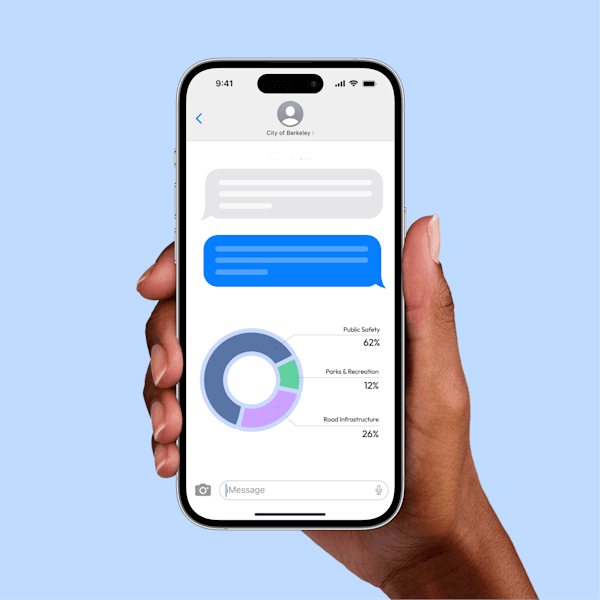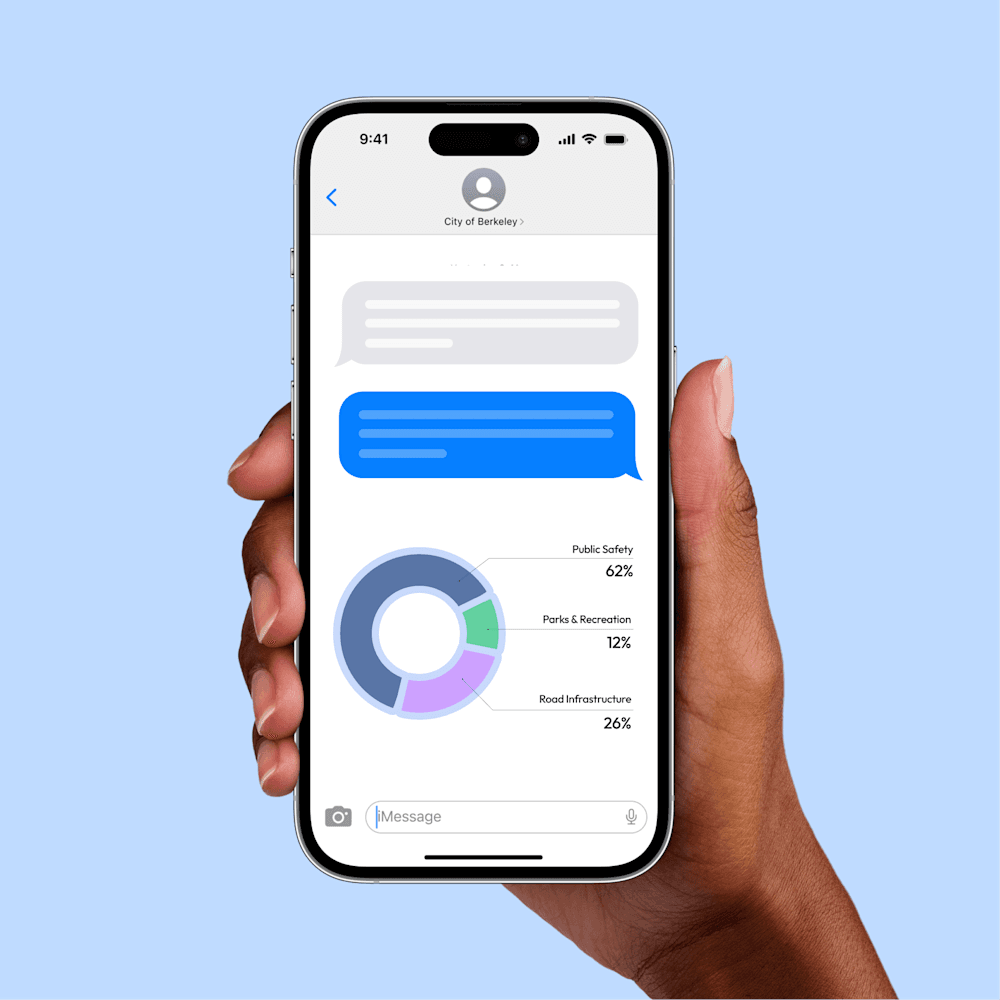
Text Polls for Local Government: Fast Feedback Made Easy
Local government decisions touch people’s daily lives more than almost anything else, affecting everything from street safety and parks to schools, zoning, and public health. But most residents are too busy to be fully involved in their local governments. They don’t have the time to attend every town hall, read every public official’s email newsletters, or respond to long online surveys.
This is where a simple tool can make a big difference: a text poll.
In this guide, we’ll break down what a text poll is, why it’s so powerful for local governments, how it compares to other ways of gathering constituent feedback, and best practices for using text polling responsibly.
What Is a Text Poll?
A text poll is a short survey sent by SMS to people’s phones to quickly gather feedback on a specific question, issue, or decision.
Instead of asking residents to find your website, attend a meeting, or click a link buried in an email, you send a simple text message like:
“Hi, this is Councilmember Lopez. Which of these should be our top priority for 2026?
Reply 1 for road repairs, 2 for affordable housing, 3 for small business support.”
People can respond in seconds, from wherever they are. Those responses are then collected, analyzed, and used to inform your decisions.
Text polls can be:
Single-question pulse checks, like “Do you support this project? Yes/No”
Short multi-question surveys with 3 to 5 short questions
Ongoing check-ins tied to specific projects or priorities
For local government officials, especially those with small teams and limited budgets, text-based public opinion polls are a fast, accessible way to hear from a much broader slice of the community.
Why Send Text Polls to Constituents?
When done well, text polling is one of the most direct, convenient ways to hear from your constituents.
Some key benefits of sending polls via text include:
Higher Response Rates: Most people read their texts. Open rates for SMS are significantly higher than for email, and residents don’t have to log in, search for a link, or navigate a long form. That simplicity makes it more likely that busy parents, shift workers, and seniors will actually respond.
More Representative Feedback: Town halls and public comment sessions tend to attract the same small group of highly engaged residents. Text polls, when sent to a broad and representative list of constituents, can help you hear from people who don’t have the time or ability to attend meetings and aren’t active in local Facebook groups or neighborhood apps. That makes it easier to avoid governing by “whoever is loudest” and instead focus on what a representative cross-section of your district actually thinks.
Faster Insights for Time-Sensitive Decisions: Some issues require fast action, like safety issues, major storms, or controversial development proposals. A well-designed text poll can give you real-time input that’s easy to interpret and share with colleagues.
Stronger Trust and Transparency: When you use text polling as part of a broader engagement strategy and you report back on what you heard, you show residents that their voices matter. Over time, that builds trust in you as a public servant, makes people more likely to respond to future polls, and reframes government outreach as a conversation, not a one-way announcement.
Text polls are ultimately one of the simplest ways to meet people where they are and bring more voices into local decision-making, especially in communities where traditional engagement tools fall short.
LEARN MORE: Explore how constituent engagement builds trust between leaders and the communities they serve.
How Text Polls Compare to Other Ways of Gathering Feedback
Every engagement tool plays a role, but traditional methods often leave important gaps.
Text polls help fill them. For example:
Most residents can’t make it to public meetings. Text polls reach them where they are. Town halls and council meetings are useful for dialogue, but they only capture the voices of those who have the time, transportation, and comfort level to show up. Text polls invite participation from people who are juggling work, family, and multiple responsibilities, expanding who gets heard.
Social media skews toward the loudest voices. Text polling broadens the input. Comments on Facebook or neighborhood apps can be helpful, but they often reflect a vocal minority rather than the community as a whole. Text polls, when done thoughtfully, reach a more representative cross-section of residents.
Email surveys get buried. SMS cuts through the noise. Email is essential for longer surveys, but open rates can be low, and many residents never see the message. Text polls create a quick, direct pathway for people to share what they think in seconds.
Many effective engagement strategies combine all three: a short text poll, a follow-up email with more detail, and a public meeting for those who want a deeper conversation. By filling the gaps with text polls, you can strengthen your broader engagement ecosystem, letting you hear from more people, more often, in ways that are more accessible.
LEARN MORE: Start building stronger connections with the people you serve using these proven community engagement strategies.
When Should Local Governments Use Text Polling?
You don’t need to reserve text polling for major crises or big-ticket issues.
Some useful moments to send a text poll include:
Budget Priorities: Asking which investments matter most, like roads, parks, public safety, housing, or youth programs.
Capital Projects: Gathering feedback on a new community center, bike lane, library renovation, or transit change.
Policy Tradeoffs: Testing how people feel about different project timelines, funding mechanisms, or implementation options.
Service Feedback: Checking satisfaction with trash collection, snow removal, public transit, or permitting.
Post-Crisis Check-Ins: After storms, heat waves, or public safety incidents, asking residents about needs and lessons learned.
The goal isn’t to hold a referendum on every decision. It’s to ground your judgment in real constituent input instead of assumptions or anecdotes.
Best Practices for Using Text Polls in Local Government
If you’re ready to use text polling to better understand your community, these best practices will help you collect meaningful, trustworthy feedback.
#1: Start With a Clear Purpose
Before you send anything, be crystal-clear about what decision your text poll will inform. A focused purpose leads to sharper questions and data you can actually use.
#2: Secure Consent and Set Expectations
Always identify yourself, explain why you’re reaching out, and offer an easy opt-out. Building trust starts with respecting people’s boundaries and following compliance rules.
#3: Keep It Short, Simple, and Actionable
Ask no more than one to three questions, use plain language, and offer straightforward response options. SMS is for quick, accessible feedback, not long-form surveys.
#4: Aim for a Representative Sample
Don’t rely on who happens to respond. Use tools that help you reach and weight input across neighborhoods, demographics, and age groups so your results reflect the full community.
#5: Write Neutral, Unbiased Questions
Avoid leading language or framing one option as more desirable than another. Neutral wording ensures you’re measuring genuine preferences, not prompting a particular answer.
#6: Close the Feedback Loop Every Time
Once you collect input, share what you heard and how it will shape your decisions. Following up is one of the simplest ways to build long-term trust and encourage future participation.
LEARN MORE: Explore best practices for designing and running effective community surveys.
How Text Polling for Governance Differs From Campaign Texts
Many residents’ only experience with political texting is during election season, and it’s often not positive. They get spammy fundraising asks, generic persuasion messages, and repeated outreach from campaigns they never signed up for.
Text polling by local government officials should be different in four key ways:
Purpose: Service, Not Persuasion. Campaign texts are usually about winning votes, raising money, or persuading undecided voters. Texts from local government, like text polls, should be about understanding needs, setting priorities, and improving public services. Your text poll should feel like an invitation to participate in decision-making, not a sales pitch.
Timing: Year-Round, Not Just Election Season. Campaign texts spike before primaries and general elections, then disappear. Text polling for governance should be ongoing, tied to real policy decisions, projects, and community needs. That consistency helps residents see you as a public servant first, not just a candidate or politician.
Tone: Respectful, Transparent, and Clear. Government-related text polls should clearly identify who is contacting the resident, explain why you’re asking for input now, and use respectful, non-alarmist language. That tone is very different from the urgency of fundraising or get-out-the-vote texts.
Compliance and Trust. Both campaign and government outreach must follow legal and ethical guidelines. But for public servants, there’s an added responsibility: maintaining institutional trust.
If your text polls feel manipulative, spammy, or partisan, you risk damaging not just your own reputation but also confidence in local government more broadly. Using language, tools, and workflows designed for compliant, ethical, nonpartisan outreach is essential.
Listen by Text, Lead With Integrity
Text polls make it easier for local governments to hear from more people, more often. By reaching residents where they already are, SMS polling cuts through the noise, delivers fast and representative feedback, and builds trust between elections.
For Independent and nonpartisan local officials, this kind of clear, accessible input isn’t a luxury. It’s essential to good governance.
With GoodParty.org Serve, that process can be made easier. GoodParty.org Serve helps local public servants understand their constituents, send thoughtful and compliant text polls, analyze responses, and turn community feedback into informed decisions, all at no cost beyond the pass-through price of SMS.
Photo by Vitaly Gariev on Unsplash
Launch your first poll with GoodParty.org Serve, and see how easy it can be to send compliant, representative text polls that help you listen first and lead better.

